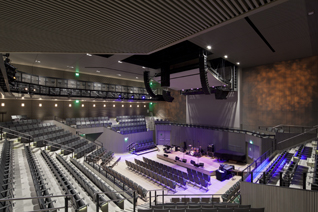Thirty years is a long time to wander, even for musicians. That changes now as SFJAZZ (San Francisco Jazz) takes the reins in its brand new home, the first freestanding building in the country designed specifically for jazz, with the help of SIA Acoustics, led by Sam Berkow.
The transparent, 35,000-square foot SFJAZZ Center was designed by architect Mark Cavagnero, with seating, stage, and auditorium configuration from Auerbach Pollock Friedlander, and acoustics and technology designed and implemented by SIA.
“SFJAZZ presents a wide range of jazz from Latin and Afro-Cuban to bebop and blues, from jazz based on solo piano performances to big bands,” Berkow said. “They have performed in all different types of venues, clubs, indoor spaces, and outdoors, and they wanted a home that offered tremendous intimacy for the community. They wanted the audience to be close to the music and to offer a sense of welcoming so that people were not entering a pretentious space but one where they could truly interact with the music.”
The purpose-built, three-story center, in San Francisco’s culture-filled Hayes Valley, features the state-of-the-art Robert N. Miner auditorium with adjustable seating for up to 700. The key issue, Berkow said, was ensuring that the sound system and the room could work together.
“Designing a room for jazz is very different than designing for classical where you try not to use the sound system and you need strong reflection across the stage because orchestras are big and have wide stages. In rock, sound on stage is irrelevant; the system is what you’re really listening to.”
Jazz, he noted, is a hybrid. “You want a room where the sound on stage needs to project without strong reflections across the stage. Unlike classical, you want a stage that is more diffuse; jazz ensembles are smaller than orchestras or are tightly packed.”
Jazz is big and powerful, and the system is meant to create balance and impact, not huge volume. “Although some SFJAZZ shows will be highly amplified, most will use the sound system to increase overall gain and to help make the bass articulate and clear and the vocals articulate,” Berkow said.
SIA worked with both the architect and Auerbach to create a number of acoustical elements in the Miner Auditorium, most prominently the steel tube acoustical canopy above the stage. “The canopy is 24-feet wide and 12-feet deep, designed to hold a great deal of sound diffusive elements,” he explained. “The goal of this canopy is twofold; to create a responsive and supportive stage environment for acoustic instruments, and to help project the sound into the audience.”
The sound system, designed to cover every seat in the house, features Meyer Sound’s MINA small-format line array technology. Each MINA includes two 6.5-inch cone drivers and one 3-inch compression driver mounted on an acoustical manifold, coupled to a low-distortion, 100-degree horizontal, constant directivity horn. Meyer cardioid subwoofer arrays also were selected.
“I’m particularly fond of the way SFJAZZ includes so many types of music,” Berkow said. “We had super-secret check concerts including a final tuning with (guitarist/songwriter) David Gans playing for us as well as a concert with a seven piece jazz ensemble for people who worked on the hall.”
Berkow said he is excited about what has been created at SFJAZZ. “We were aiming high and we will get what we and they wanted. I really like being a part of creating a great music venue. I like building rooms where I like to go. I’m a music fan; I’m part of the audience. And this is the type of room I look forward to attending, particularly for the upcoming Zakir Hussain concert with Edgar Meyer and Béla Fleck. Working with someone like (SFJAZZ executive director) Randall Klein, who has an exciting vision for the space, makes you want to work harder and push your own limits.”
And the buzz has been ongoing. Recently, San Francisco’s KQED radio aired an interview with Berkow about the SFJAZZ acoustics. “How often,” he asked, “does that happen?”











